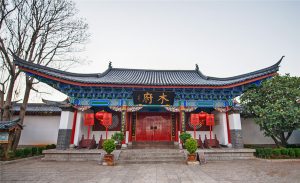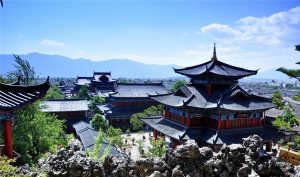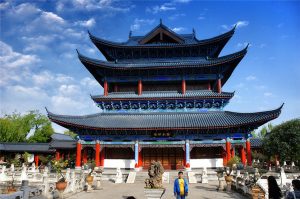
Mu Palace in Lijiang
● Chinese Name: 木府
● Chinese Pinying: Mu Fu
● Keywords: Naxi Ethic Group,Mu Palace,Mu Mansion,Tusi Mu,Naxi Culture,Miniature Forbiden City
● Location: No.49, Guangyuan Alley, Gucheng District, Lijiang City, Yunnan
● Best Time to Visit: All year
● Admission Fee: 60 RMB
● Open Time: 08:30 - 17:30
Why is Mu’s Residence so special?
Lijiang Ancient Town is well-known as one of the famous cultural heritages in China, while Mu’s Residence is the highlight of this old town. Located at the southwest part of Lijiang, the Mu’s Residence was the mansion of the Mu family, the ruler of Naxi people that ruled Lijiang for about 470 years in ancient China, as well as the government office of Lijiang, which was built symmetrically according to imperial palace of Han minority ethnic group.
Where is Mu’s Residence?
Mu’s Residence is situated in the southwest of the Old Town of Lijiang. It is the Tusi Mu’s Yamen of the Naxi Ethnic Group in Yunnan. Tusi Mu was the ruler of Naxi during the Yuan (1271-1368), Ming (1368-1644), and Qing (1644-1911). During their reigning, this residence was the center of politics, power and wealth in ancient Naxi. Although it is simply a residence, it holds the majestic essence of a palace. In the heyday of the Tusi Mu, it covered an area of over 100 mu (about 16 acres) and consisted of almost one hundred buildings. It could be said that it was a miniature Forbidden City. Unfortunately during warfare in the Qing Dynasty most of the residence was destroyed. The present day Mu’s Residence was rebuilt from 1996-1999. The reconstruction is based on the original site and captures the magnificent image of what life was like at this great palace.
What to see in Mu’s Residence
Mu’s Residence today covers an area of 46 mu (about 8 acres) and spans a length of 369 meters (about 404 yards). It sits against the Shizi Mountain (Lion Mountain) and faces east in the direction of sunrise. The residence is made up of two areas: the office area and the living area. Upon entering the gate, one can see Yishi Hall (Meeting Hall) at the end of a vast square. This is the beginning of the office area. Yishi Hall is the place where Tusi conducted official business. This magnificent building is surrounded by dignified white marble balustrades. Three wood steles written with ‘chengxinbaoguo’ (meaning ‘devoted to the country’) by three Emperors in Ming are hung on the hall. Behind the Yishi Hall, there is the Wanjuan Pavilion, ‘wanjuan’ meaning numerous books. The pavilion houses thousands of sutras and many paintings and calligraphy works of famous scholars. Behind the Wanjuan Pavilion, lies Hufa Hall, the place of sacrificial activities. These main buildings all lie on an axis to the residence. Shizi Mountain can be reached from the rear of the residence. To the north there is a vast area dispersed with a series of courtyards. This is the living area of the Tusi and his families. Divided by a bounding wall, the layout of these courtyards bears striking resemblance to the living area found in the Forbidden City.

What are features of Mu’s Residence?
Mu’s Residence reflects the architectural style of the central plains of China during the Ming and Qing Dynasties. Its layout is arranged according to the pattern of the Forbidden City. Decorative work, including carvings and paintings of buildings, are similar in style to those in the palace of Ming. Most of the decorations are simple but sublime showing the dignity of the ruler. Some of the buildings show the delicate characteristics of landscape gardens in south China.
Mu Family’s History
Since the ancient time, Lijiang was the dwelling place of Naxi minority. There was no Han minority name of Naxi minority. When Zhu Yuanzhang (Taizu Emperor of Ming Dynasty) built Ming Dynasty, the minority hereditary headmen of Naxi in Lijiang called Aji Ade immediately shown the honesty of Zhu’s ruling. Zhu was extremely delight so he decided to reward a Han minority family name to Aji Ade and his group. The rewarding family name was “Mu”. From that on, all the Naxi minority hereditary headmen need to used “Mu” as their family names.
During the Mu’s ruling time, aimed to maintain the nobility of their family, they promoted a family name system “Officials with Mu family name, and citizens with He family name”. Mu minority hereditary headmen was passed till the Qing Dynasty.
With Yuan, Ming and Qing three dynasties, Mu’s Palace once covered more than 100 mu, regarded as the heart of Dayan Ancient Town. Surrounded by residents’ houses, Mu family was a respectable family among locals’ minds. Mu’s family followed the discipline “Be knowledge, read literature, and keep righteousness”.

Layout of Mu Residence
The Mu Mansion is built against the Shizi Mountain on an east west axis with the complex facing east. The mansion is divided into two areas, the administrative area and the residential area.
The first part of the mansion is a large courtyard that ends at the Yishi Hall which was the administration center and used by the Naxi head men for meetings with the head of the Mu clan and discussing business. The second part is the Wanjuan building is used to house thousands of scrolls, paintings and sutras. The last administrative building is the Hufa building which was used for making sacrifices.
The residential area is in the northern part of the mansion and separated from the administrative area by a series of ponds and streams that are charming and captivating. The buildings in the residential area are based on a series of courtyards and share similarities to the residential areas in the Forbidden City.
Architectural Complex of Mu’s Residence
– Stone Memorial Arch of Loyalty (忠义石牌坊),
– Yimen Meeting Hall (仪门议事厅),
– Wanjuan Building (万卷楼, a library collecting thousands of scriptures of the Dongba religion and many other poetry anthologies, books and paintings),
– Hufa Hall (护法殿, also called the Hind Meeting),
– Guangbi Building (光碧楼, the entrance tower of the garden of the backyard),
– Yuyin Lou (玉音楼, the building for holding banquet and receiving imperial decree),
– Sanqing Hall (三清殿, Taoist temple for worshipping),
and side halls, attic, yards, rest rooms, corridors, and so on, totaling 162 rooms.
Neighboring Shizi Mountain (狮子山, or Lion Mountain), the existing Mu’s Residence covers an area of 30,667 square meters. Although the Mu’s Residence was designed modeling the Han style, its entrance did not face south but east, as according to the religion of Naxi, the element “wood” (木 in Chinese, one of the Chinese Five Elements Theory, concerning metal, wood, water, fire and earth), which is same character with the family name of Mu Family, should represent the East, and both element wood and the sun are holy things.

Distinguishing from houses of other rich people, the Mu’s Residence is not surrounded by walls, as the Mu family considered that the connecting walls look the Chinese character 口 and it will form another Chinese character 困 (“be trapped” in English) with their Family name 木 inside.
Besides designed with architectural styles of Han, Naxi, Bai ethnic groups, the Mu’s Residence is also a combination of royal garden and Suzhou garden collecting exotic flowers and rare herbs at its backyard.
Specialty Product of Mu’s Residence
As a liquor once dedicated to the eminent Mu Family only, the Milord Mu Liquor (木老爷酒) has had a history of more than 500 years. Fermented from selected buckwheat and spring water from Yulong Snow Mountain, the liquor is processed by many complicated and secret steps.
After the Mu Family declined, the brewing of the liquor almost disappeared until the rising of tourism of Lijiang. Nowadays, Naxi people combine their traditional brewing technology and modern production line to reproduce the Master Mu Liquor.
How to get to Mu’s Residence
First people need to get Lijiang Ancient Town.
Visitors can reach Yudai Bridge on foot or by bike and then cross the bridge to enter Mu’s Residence.
| Entrance Fee | CNY 60; Free for children under 1.2m (3.9ft). |
|---|---|
| Opening Hours | 08:30 – 17:30 |
Recommended Visiting Route
Travelers can visit Lijiang Old Town through the South Gate, on the way, you’ll pay visit to Mu’s Residence, Lion Hill and Wangu Tower and wander through the old streets and lanes to enjoy leisure feel of the old town. This may take you half day to explore.
Spend another 2 hours to the north of Lijiang Old Town by visiting Black Dragon Pool Park and Dongba Culture Museum. If time permits, you can enter Lijiang Old Town through Black Dragon Pool Park and see the symbol of the town – Large Water Wheels and walk straight to Sifang Square to enjoy the evening performance held by the Naxi people.
1 Day Lashihai Lake Boat Cruise and Horse Riding Tour along the Ancient Tea Horse Road
2 Days Lijiang Jade Dragon Snow Mountain and Baoshan Stone Town Tour
Recommended Accommodation
1.Inter Continental Lijiang Ancient Town Resort(丽江和府洲际度假酒店)
Located in the southern of Lijiang Old Town, the InterContinental Lijiang Ancient Town Resort is the international five-star conference and resort which combines modern luxury, traditional Naxi architectural, and the local representative landscape. Hotel has 274 spacious rooms and suites, 4 restaurants and bars, Spa and Fitness center. It is a 10-minute walk from Sifangjie (Market Square), a 30-minute drive from Lijiang Airport.
2.Hotel Indigo Lijiang Ancient Town(丽江古城英迪格酒店)
Hotel Indigo Lijiang Ancient Town is located in Lijiang Ancient Town. It features a wellness center, an indoor pool and a fitness center. The luxurious rooms offer free wired internet. At Hotel Indigo Lijiang Ancient Town you will find a la carte restaurant and buffet restaurant. Breakfast can be served in the comforts of guests’ rooms.
3.Lijiang Wangfu Hotel(丽江王府饭店)
Lijiang Wangfu Hotel is located in the South Gate Square in Old Town. Featuring colorful traditional Chinese architecture and décor, it offers rooms with flat-screen TVs and free internet. Guest can enjoy Naxi bonfire party every Friday. The hotel provides car rental and concierge services. A tour desk can help with travel and sightseeing arrangements.
4.Manty House(漫庭美宿酒店)
Situated in Lijiang, this inn is within a 15-minute walk of Mu Family Mansion, Dayan and Wang Gu Lou. It features a restaurant, a bar/lounge and coffee/tea in a common area. WiFi in public areas is free. Other amenities include dry cleaning, a 24-hour front desk and tour/ticket assistance.
5.Lijiang International Hotel(丽江国际大酒店)
Lijiang International Hotel is located in Lijiang, 400 m from Wangu Pavilion and 600 m from Square Street Dayan Ancient Town. Guests can enjoy the on-site bar. Every room at this hotel is air conditioned and is fitted with a flat-screen TV with satellite channels. You will find a coffee machine in the room. For your comfort, you will find bathrobes and slippers.

Travel Tips of Mu Mansion
● Guides of the Mu’s Residence will introduce the history of the residence and the Naxi minority ethnic group when there is a cluster of visitors visiting there.
● On the eighth day of the second Chinese lunar month (usually falls bwteen the end of February and the beginning of March), the Sanduo Festival (三朵节), an important festival of Naxi people, will be held in Lijiang. Sanduo is said to be the guardian god of Naxi minority ethnic group and the reincarnation of Yulong Snow Mountain. During the festival, Naxi people will play Naxi ancient music and go picnic in the open.
● Make it clear whether the local activities are free to participate before you join in them.
Others Scenic Area:
Lijiang old Town is officially called “Dayan Town”, “Dayan” literally means a “great ink stab”, a graphic description of the town’s location on a piece of rich flatland fed by a river and surrounded by green mountains. It is a well-preserved Naxi ancient town, listed as UNESCO World Heritage site in 1997. It is one of the four best-preserved ancient cities in China. The unique geographical location, historical background and multiracial inhabitants make it one of the most popular travel destination in China.
Located in Yulong Naxi Autonomous County, Lijiang City, Yunnan Province, Jade Dragon Snow Mountain is 15 kilometers north of the downtown, which has a highest altitude of 5596 meters and an area of 455 square kilometers. With thirteen perennial snow peak, Jade Dragon Snow Mountain resembles a jade dragon lying in the clouds, hence the name. Featured by its magnificence, precipitousness, uniqueness and beauty, the scenery of Jade Dragon Snow Mountain changes in accordance with seasons and weathers.
Nestled at the foot of Jade Dragon Snow Mountain, 6 km northwest of Lijiang old town, Shuhe Old Town was once a staging post at ancient Tea & Horse Road. With an altitude of 2440 meters above sea level, it is a tranquil town with a population of about 3000 people. Along with its sister town Lijiang, it is also part of the UNESCO Heritage site. Shuhe is the earliest settlement of Naxi people in Lijiang when their ancestors first moved to this region.
Baisha Old Town is one of the oldest towns in Lijiang City. It got its name “Baisha” meaning “white sand” from the natural white sand in the area. It was the cradle-land of the Tusi Dynasty evolved from the Mu Clan. It was also the earliest settlement of the Naxi people. In ancient times, Baisha was a center of silk embroidery in southwest China and an important place on the Ancient Tea and Horse Road.













